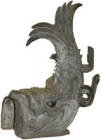Japanese Gallery (Honkan) Room 16
October 10, 2007 (Wed) - November 11, 2007 (Sun)
The fact that the Edo period lasted 260 years was largely due to the first three Tokugawa Shoguns: Ieyasu (1542-1616), Hidetada (1579-1632), and Iemitsu (1604-51). Together, they built a framework and system that allowed their legacy to continue, peacefully, until the Meiji Restoration of 1867.
Tokugawa Ieyasu is still recognized today as a brilliant strategist and planner. Hidetada strengthened his military power by having children marry into powerful families - both noble and military - and realized his power when he called the Emperor to visit Nijo Castle in Kyoto and monopolized trade. Iemitsu strengthened restrictions against samurai families and enacted a system that forced Daimyo (feudal lords) to alternate between their fiefs and the capital. The lavish palaces in Edo, ceremonies, and other necessities required by the Shogun resulted in huge cash outlays by the Daimyo and decreased their economic power - thus hindering their ability to assemble armies against the Shogun. Iemitsu also developed stable relations with the Imperial court.
However, the most powerful symbol of the Shogunate's strength was Edo Castle. It was first built by feudal lord Ota Dokan during the Choruku era (1457-60). Ieyasu expanded the castle and fortified its defences. It was burned and torn down in the chaos of the Meiji Restoration of 1868, when the Shogunate folded and returned authority to the Emperor. The castle no longer remains, but it continues to exist in the various documents and artifacts.

